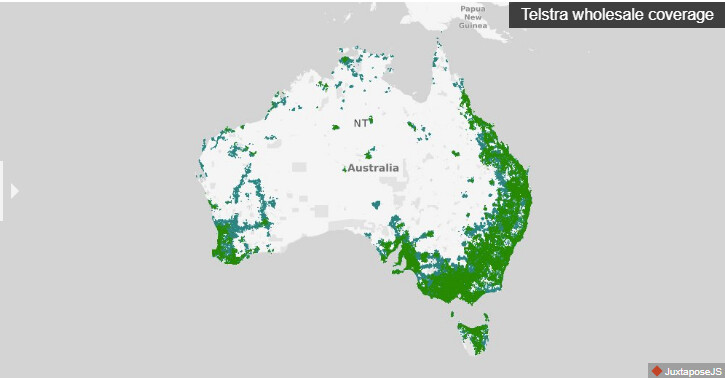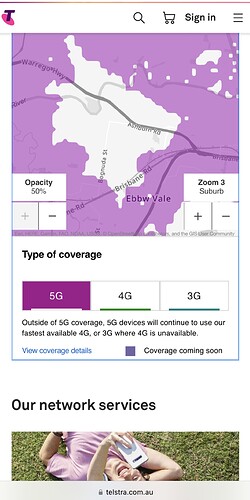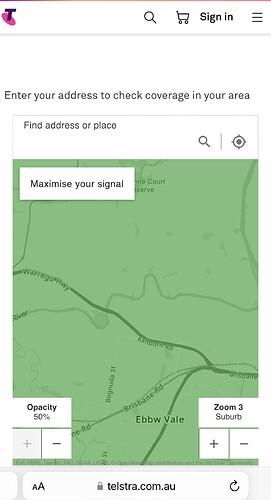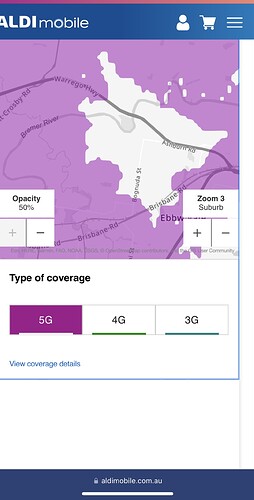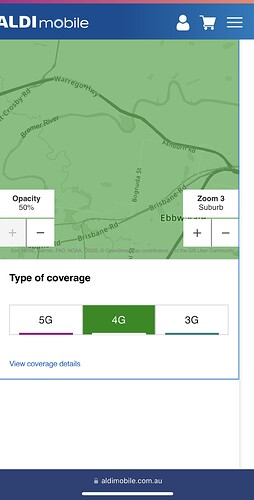I agree, although the one point i will concede is Treeless customers get better coverage. If you’re with someone else like ALDI, Coles, Amaysim etc, your the first one off when the network gets congested. I’ve sat, signal free, beside a full service customer who has no problems. But it doesn’t happen that often
I do not doubt that happens as you posted, but it can also happen because of one’s mobile. For example a Moto g6+ versus an Oppo Reno8 Lite is anecdotal, yet the Moto often had 0 to 1 bar and the Oppo always has 2 or 3 bars, each on Aldi and amaysim.
Both phones are dual SIM, one Aldi and one amaysim. Trying to ring out on the Moto via Aldi would often fail as the signal dropped; never had that happen with the Oppo. It has to do with the chipsets and how the antennas are embedded in the phone case.
Another fascination is Aldi usually had a relatively better signal (although it was often unusable) around the house on the Moto compared to the amaysim, and the amaysim was less usable even more often. In contrast the Oppo always shows more bars on the amaysim SIM around the house than the Aldi SIM, and the Oppo has yet to drop a signal on a dial out on either SIM.
For some insight check mobile reviews on Cybershack. There are relevant comments on the Moto and Oppo phone (and other mobiles) reviews that reinforce it is not just the networks in play. Sad to add I find Cybeshack’s mobile reviews put Choice’s to shame.
What you say is certainly true, & I agree Cybershack it’s a great resource, which I recently used to help me choose a new phone. I finally got Samsung Galaxy S22 Ultra (mainly as I could use Qantas points that certainly weren’t helping us get cheap flights for the past 5+ years). It got a good write up for its reception compared to Pixels or cheaper Galaxy phones, so I was surprised when I noticed it often only shows 1-2 bars when my old Oppo R17 Pro would have 4. But I found issues with signal strength in particular around the local shopping centre, & especially around Xmas time on both the Oppo & it’s predecessor, a Nexus 5X, which is why I put it down to ALDI. Haven’t had issues with the new phone yet, but it’s not the Real Xmas season yet!
It is most likely that you have picked up that Aldi uses the :
More correctly the Mobile Virtual Network Operators (MVNO) buy capacity and coverage on the Telstra network.
It is possible that one phone is connecting to the full Telstra network which is closer (Telstra or full coverage Telstra customer), while your phone is connecting to the further away MVNOs (wholesale) network that Aldi uses.
The difference in coverage can be seen from these two images (source Whistleout):
Part of the Telstra network used by MVNOs such as Aldi):
There can be differences in reception/coverage not only in regional areas, but in built up areas which can explain why a MVNO phone has different connection strengths/reliabilities to a full Telstra network phone at the same location.
.
We live in a location that has variable mobile coverage. I’ve a full service Telstra mobile, until recently full service Optus account, and now use a MVNO (our NBN RSP) which uses the Optus Network. We’ve family who visit or stay and use different mobile phone models as well as other third party mobile service providers.
Our side by side comparisons suggest.
The reliability of connection and service depends predominantly on the model of mobile phone. For us there are no conclusive observations that the mobile service provider makes any difference.
We are all able to speculate. A better option would be to ask OPTUS, Telstra and TPG/Vodafone the basis of the capacity/provisioning they provide to their MVNO clients. Assuming it’s not already transparent, it would be a reasonable request by the ACCC that would enable customers of the third party mobile service providers to ensure they are making a fully informed choice. Perhaps it’s a step too far?
Same pair of SIMS in the Moto and then the Oppo in my anecdotal report.
It could be anything, but on balance of probabilities the differences in the phones cannot be summarily dismissed, obviously allowing for the experience @ItAintMe posted to be complex per capacity, etc etc, and the disparities @phb called out between full and wholesale network services; yet the phones matter and few probably focus on them as part of their service equation.
If we agree to agree, is the logical outcome consumers are not assured of equal service from the same tower and or cell when serviced through different providers?
One of @phb observations concerns differing access where the physical network asset owner does not provide access in certain areas. It seems unlikely to be an urban concern. Aldi promotes using part of Telstra’s 3G, 4G and 5G networks. With Aldi 5G covering 75% of Australia’s population.
There is an opportunity here for Choice to provide a more objective assessment. Is it possible the Telcos might respond to Choice inquiring without need for any real world network test?
On value:
Should any consumer grumble about being second best on Telstra’s network if their chosen provider is half the cost? Alternately should any on full fat Telstra accounts complain about the premium price? It’s certain the last mentioned would see cause to complain if there was no difference in service connection priority provided irrespective of provider.
The more interest this topic generates in the community the greater the need to have clarity.
That is a good question, and the answer is a transparent ‘they do not have the same services’ because for example an MVNO although cheaper can have capped speeds. Would they get lesser basic service though? Systems are quite capable of applying rules for each MVNO.
Ask the networks about the coverage around my area. 100% brilliant and even 5G, except for a very large segment of our community that routinely complains about dodgy coverage. What percent of the community uses MVNOs is an unknown. In my case the coverage issue in my house has gone from seriously bad to almost non-existent by a change of phone. That would be consistent with a variable and weak signal and the ability of the phone to acquire, keep, and use a weak signal.
What would you propose ‘objective’ needs to include? The basic signals? The services for the network major and for each MVNO? And for a wide range of phones? I suggest seeking absolute clarity is a search for the ‘holy grail’ because of the numbers of variables. It could become data like the ACCC NBN reports - data is good but what does it mean?
In city centres possibly less concern, but the further out such as in suburbs or the ‘urban fringe’, the differences possibly will become more apparent. In outer areas, there will be areas which aren’t fully covered by MVNOs, and better covered by the Telstra full network.
Even in regional centres like where we live, those on the MVNO network get patchy service where those in full Telstra network have better coverage. I suspect that the MVNOs use the town tower, while those on full network also have the luxury of (overlap) towers located outside town where signals penetrate into the town, thus increase potential service coverage. We have guests who use MVNO, Optus and Vodaphone/TPG networks and often complain of the lack of good, reliable signals at various times.
75% also does not mean 100% reliability in such areas. It means 75% have been mapped as having some sort of signal coverage. Even with 75% potential population coverage, it means 8.5 million without any coverage at all.
FWIW I have a device using a (GPRS service) modem located ‘in the house’ using a Telstra SIM and it routinely has been found to drop back from 4G to 3G with 0 bars while usually but not always still being able to communicate. Telstra contends I am in a strong 5G area suggesting 4G should be the reliable backup ![]() (the modem is not 5G)
(the modem is not 5G)
Add all the possibilities and observations together and concluding much of anything might be hit or miss since it is ‘an all together’ problem where all variables have to be considered.
This thread is interesting enough to deserve its own topic.
Start with the most basic of requirements and look to finding a reliable answer to if and how Telstra manages Aldi customers on the Telstra network compared to their own for,
- I need to make a call, will Telstra place my mobiles request to complete a connection through the cell with a priority the same as or less?
- If a cell is congested will Telstra selectively push away Aldi customers attempted connections outgoing or incoming to favour it’s own?
- Is there greater potential when the local cell is very busy for a Telstra serviced customer to get a 000 call through than any other?
- For SMS are they queued equally in turn irrespective of Telstra or Aldi, or will Aldi customers note more delays in one or both directions?
It’s a given that for data services there is a proportionate cost (value judgement) for speed and volume. Something most users can feel, understanding optional.
Most of us now depend on our mobiles.
For the basic service of making and receiving a call should there be any difference between whose brand of sim one chooses? We used to a have a meaningful service guarantee for the old home phone. I’d expect Choice would know who to ask and how to go about providing a solution if testing for any differences as above.
P.S.
Yes, a topic of its own if you accept there being real differences in coverage and connection for essential needs. It suggests allowing Telstra in particular to differentiate is creating an unequal and unfair competitive advantage.
In my area, I get both good 4G and 3G (3G removed in mid 2024), I can’t get 5G with the ALDI service, we sit in a blank on the coverage map. Telstra 5G and 4G coverage map for the same area is a match to ALDI’s map.
I’m in a white patch too, unlikely to ever get 5G unless they put a cell in the street. Sadly, my 4G is “covered” but the signal is weak. No VoLTE yet.
Ookla as well as running the most popular speed tests for fixed line also does it for mobile and records location with latency and upload and download speeds.
There’s a map as well.
Ookla is a great service, and in comparing its results with other speed reporting tools reliably consistent.
What Ookla does not do is assess and compare the ability for a mobile service to meet basic needs such as making and receiving voice calls, or SMS. It needs someone with a detailed working knowledge of how the mobile network identifies handsets in cell range and completes connections to comment.
So many topics this is appropriate, but will this be a game changer with Optus covering 100% of the continent challenging Telstra as well as the NBN in the regions and maybe beyond?
The deal, announced on Wednesday, will see Optus use low-Earth orbit satellites to deliver voice calls, data and SMS messages in an Australian first when services launch in the next two years.
Industry analysts say it could help connect “under-serviced” phone users in remote and regional areas who were still without coverage, though the partnership was unlikely to see Optus seriously challenge Telstra for network speed or reliability.

